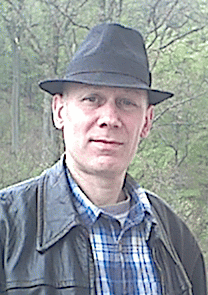Curriculum
Vitae, Andrew Cameron Morris, October
2005 (pdf
version)

Current position
Research
Associate at IRCAM, on project VIVOS,
working on expressive speech synthesis for use in T2S for computer
animation and voice adaptation for possible use in the entertainment
industry (games and
films).http://recherche.ircam.fr/equipes/analyse-synthese/vivos
Qualifications
- 1992 PhD: Doctorate of the Institute
National
Polytechnique de Grenoble, "An information-theoretical study of speech
processing in the peripheral auditory system and cochlear nucleus:
application
to the recognition of French voiced stop consonants" (grade "Tres
honorable,
avec felicitations").
- 1988 B.A. Hons. in mathematics (grade:
2-1)
- 1979 RIBA Part 1 (BA) architecture
- 1973 A level Maths (1), further maths
(1), special
maths (1), physics (2)
- 1973 Driving licence, car and motorbike
Natural
languages
English
(native), French(good),
Spanish (good)
Computer
languages
C (19
years), C++(3 years), Java
(6 months), Pascal, Fortran, Linux and Windows operation systems.
Research
interests
- Expressive speech synthesis
- Natural language understanding
- Speaker verification & identification
- Computer speech recognition
- Machine learning (including Hidden Markov models, neural
networks, Bayesian networks)
- Neurocomputing applications
- Probability and information theory
General
interests
- Philosphy of mind & neural modelling
- Fitness (including football, skiing, jogging, swimming, squash,
badminton,
table-tennis,
salsa)
- Painting, drawing, sculpture, architecture, music
(ex guitarist in
flamenco group)
Relevant
technical skills
- Programming for real-time biometrics based user authentication on
PDA (C++ & Java) (combining voice, face and signature)
- Programming state of the art and novel methods for speaker and
speech recognition (C/C++)
- Applied mathematics (including differential calculus, linear
algebra, information theory, graph theory, operations research,
statistical analysis, machine learning, signal
processing)
- HMMs, neural networks & Bayesian networks for speech
recognition, speaker recognition and time series prediction (21 years),
2D computer graphics for map and image processing (5 yrs), 3D computer
graphics for engineering (1 yr).
Previous
experience
Research
Associate, Dept. of Phonetics, Saarbrücken University, Germany.
Member of
SecurePhone team
working on implementation of multi-modal
person
verification on a PDA (Personal Digital Assistant).
Applied data enhancement technique
from speech recognition to improve performance of speaker recognition.
- 1998-2002
Research Scientist, Institut Dalle Molle d'Intelligence Artificielle
Perceptive (IDIAP), Martigny,
Switzerland.
Created
mathematical model for all-combinations multi-band and multi-stream
processing.
Also contributed to other theoretical developments and implementation
of novel techniques for
noise
robust ASR. New techniques were developed in the areas of the
multi-band,
multi-stream
and missing-data processing. Work was within the European Commission
projects
MULTICHAN, COST249, SPHEAR and RESPITE. 2 journal publications. 14
conference publications.
Presented 1 week course "Neural
networks in
automatic
speech recognition", 18-25 June 2001 Institute for Biomedical
Engineering,
Graz, Austria (for Prof. Gert Pfurtscheller).
Supervised 2 PhD students. Member of PhD jury for Astrid Hagen,
December 2001,
EPFL, Lausanne.
- 1995-98
Research associate, Speech and Hearing
Research Group,
Sheffield University, Dept. of Computer Science.
Developed
formal solution to the general problem of pattern recognition with
missing data.
Theoretical and practical development of the "missing data"
approach to
noise robust ASR, within the EC SPHERE project. 2 conference
publications.
Participated in EC "tempus" project for the
advancement
of computer science teaching in Romania.
- 1993-95
Research Associate, GTH (Speech
Technology
Group), ETSI de Telecomunicación, Universidad Politecnica de
Madrid,
Spain.
Some work on reducing the computational complexity for a
model
for simulating the behaviour of small groups of neurons. Applied
auditory
model for onset detection to phoneme transition detection in ASR
system. 2 conference publications.
Created system for speech
recognition using only the fraction of speech data which occurs at
phoneme transitions. This was based on a new technique for phoneme
transition detection which was developed during my PhD.
1995 Chairperson, session MOpm2E "Auditory
models",
Eurospeech '95.
1995 Member of PhD jury for Sr. Manuel
Leandro,
July 1995, ETSIT, UPM, Madrid.
- 1989-93 Research assistant, European project
SC1.0044.C(H)
"Investigation of automatic speech recognition based on a physiological
model of the auditory system", ICP (Institut de la Communication
Parlée),
INPG, Grenoble, France.
Investigated the role played by cells in
the
cochlear nucleus in speech recognition. Established (among other things) that type
1 onset neurons are involved in phoneme transition detection, while
type 2 onset cells measure pitch. Developed practical methods for
detecting phoneme transitions and for mapping
the
distribution of phonetic information over the auditory spectrogram.
Demonstrated that the information theoretical measure of mutual
information is proportional to Pearson's large sample statistic for
testing statistical dependence in contingency tables. 1 jounal
publication. 2 conference publications.
- 1984-89
Programmer, Laser-Scan Laboratories Ltd.,
Cambridge,
UK.
Introduced
new high speed algorithm (quad-tree processing) for vector image
processing.
Contributed to new applications in map and
image
processing, and geographical information systems, in Fortran and C.
Participated
in Alvey project MMI-137, "Real-time 2.5D Vision". 2 conference
publications.
- 1983-84
Research assistant, computer aided
engineering, Polytechnic
of Central London, UK.
Discovered
useful formula concerning the exact shape of the space swept out by a
moving convex polygon - though it was later found that this had
been discovered before!(
Pascal programming applications in 3D
engineering
graphics and machine tool control. 2 technical reports.
Publications
Referees
